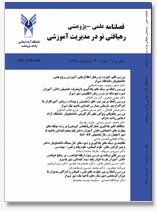طراحی مدل تاثیر فناوری اطلاعات درآموزش کسب وکارهای کارآفرینانه با تاکید بر چابکی سازمانهادر ایران.
محورهای موضوعی : آموزش و پرورش
مهرداد رضایی
1
![]() ,
طهمورث سهرابی
2
*
,
طهمورث سهرابی
2
*
![]() ,
مهدی کریمی زند
3
,
مهدی کریمی زند
3
1 - دانش آموخته دکتری گروه مدیریت فناوری اطلاعات،واحد تهران مرکزی،دانشگاه آزاد اسلامی ،تهران ،ایران.
2 - استادیار رشته گروه مدیریت صنعتی،واحد تهران مرکزی،تهران، ایران.
3 - استادیار رشته گروه مدیریت بازرگانی،واحد تهران مرکزی،تهران، ایران.
کلید واژه: فناوری اطلاعات, کسب وکارهای کارآفرینانه, چابکی سازمان,
چکیده مقاله :
مقدمه و هدف: هدف پژوهش حاضر طراحی مدل تاثیرگذاری فناوری اطلاعات در آموزش کسب و کارهای کوچک و متوسط کارآفرینانه با تاکید بر چابکی سازمان رها در ایران است .
روش شناسی پژوهش: در این تحقیق از روش های مصاحبه، مشاهده و فیش برداری جهت گردآوری اطلاعات استفاده شده است. مشارکت کنندگان به گونه ای انتخاب شدند که فعالیت آن ها در حوزه فناوری اطلاعات ودرآموزش کسب وکارهای کوچک و متوسط کارآفرینانه بوده و در کار خود دارای سوابق ارزشمندی بوده اند، تعداد نمونه بین 10 تا 25 نفر در نظر گرفته شد. روش نمونه گیری در این پژوهش از نوع گلوله برفی می باشد.
یافته ها: پس از انجام مصاحبه ها، متن مصاحبه ها به دقت پیاده سازی شد و به همراه یادداشت های برداشته شده برای تجزیه و تحلیل مورد استفاده قرار گرفت. برای تجزیه و تحلیل متن مصاحبه ها از روش تجزیه و تحلیل تم که در تحقیقات کیفی کاربرد گسترده ای دارد استفاده شد. به منظور شناسایی مولفههای طراحی مدل تاثیرگذاری فناوری اطلاعات در آموزش کسب وکارهای کوچک و متوسط کارآفرینانه با تاکید بر چابکی سازمان در ایران به مصاحبه با 12 نفر از متخصصان و خبرگان که از اساتید دانشگاه، مدیران و کارشناسان فناوری اطلاعات و حوزه آموزش کسب و کارهای کارافرینانه بودند، پرداخته شد.
بحث و نتیجه گیری: در این پژوهش تلاش شده است تا با ارایه الگویی موثر به درک بهتری از تاثیر فناوری اطلاعات و اثربخشی این ساختار بر بهبود آموزش وپویایی کسب وکارهای کوچک ومتوسط کارافرینانه دست یافت .همچنین مدل مفهومی تحقیق از برازش مطلوبی برخوردار بوده است.
Introduction: The purpose of this study is to design an effective IT model in training small and medium entrepreneurial businesses with emphasis on the agility of organizations in Iran.
The research method is based on the theory derived from data and the statistical population of this research in the qualitative section, managers and heads and university professors are introduced as experts in the research, which uses a semi-structured questionnaire and in-depth interviews with experts. From the initial model modification (discovery of new variables, modification of the original model variables) the final model was obtained using MAXQDA software. And in the quantitative part, managers and employees of small and medium entrepreneurial businesses in Fars province are considered. The sampling method in this study is snowball.
Findings showed that the main variables of information technology model to improve education were the quality of technology management, business alignment, innovative performance, opportunism, technology integration, infrastructure and value creation.
research methodology: In this research, interviewing, observation and data collection methods have been used to collect information. The participants were selected in such a way that their activity in the field of information technology and training of small and medium businesses were entrepreneurial and they had valuable records in their work, the number of samples was considered between 10 and 25 people. The sampling method in this research is snowball type.
Findings: After conducting the interviews, the text of the interviews was carefully implemented and used for analysis along with the notes taken. To analyze the text of the interviews, the theme analysis method, which is widely used in qualitative research, was used. In order to identify the design components of the information technology influence model in the training of small and medium entrepreneurial businesses with an emphasis on the agility of the organization in Iran,
_||_

